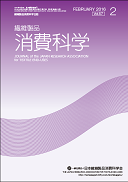All issues

Volume 50, Issue 2
Displaying 1-11 of 11 articles from this issue
- |<
- <
- 1
- >
- >|
-
[in Japanese]2009Volume 50Issue 2 Pages 114-115
Published: February 20, 2009
Released on J-STAGE: April 26, 2016
JOURNAL RESTRICTED ACCESSDownload PDF (401K)
-
[in Japanese]2009Volume 50Issue 2 Pages 116-120
Published: February 20, 2009
Released on J-STAGE: April 26, 2016
JOURNAL RESTRICTED ACCESSDownload PDF (1054K)
-
[in Japanese]2009Volume 50Issue 2 Pages 121-126
Published: February 20, 2009
Released on J-STAGE: April 26, 2016
JOURNAL RESTRICTED ACCESSDownload PDF (1275K)
-
[in Japanese]2009Volume 50Issue 2 Pages 127-132
Published: February 20, 2009
Released on J-STAGE: April 26, 2016
JOURNAL RESTRICTED ACCESSDownload PDF (1227K)
-
[in Japanese]2009Volume 50Issue 2 Pages 133-139
Published: February 20, 2009
Released on J-STAGE: April 26, 2016
JOURNAL RESTRICTED ACCESSDownload PDF (1310K)
-
[in Japanese]2009Volume 50Issue 2 Pages 140
Published: February 20, 2009
Released on J-STAGE: April 26, 2016
JOURNAL RESTRICTED ACCESSDownload PDF (251K)
-
Yuan XUE, Haruki IMAOKA2009Volume 50Issue 2 Pages 141-153
Published: February 20, 2009
Released on J-STAGE: April 26, 2016
JOURNAL OPEN ACCESSIn this study, color psychological aspect was investigated among some Japanese and Chinese students. Forty five colors were selected as stimuli, and forty three questions were asked. The answers were analyzed using histogram intersection method. Four sets of histogram intersection values were obtained for four comparison pairs, which included Chinese female / male (C-FM), Japanese female / male (J-FM), Japanese and Chinese females (F-JC), Japanese and Chinese males (M-JC). From these values, the differences between various groups' answers to each question could be analyzed. Then, mean difference test was used to compare these four pairs. The general order of differences among the four pairs from small to big was C-FM<<J-FM<F-JC<M-JC.View full abstractDownload PDF (1614K) -
Features of Design Image Key Words and its 3D-Garment DesignsTomoe MASUDA, Kaori MURAKAMI, Yuka HIRABAYASHI, Mitsuro NAGANO2009Volume 50Issue 2 Pages 154-164
Published: February 20, 2009
Released on J-STAGE: April 26, 2016
JOURNAL OPEN ACCESSIn this third part of our papers, for the information of a garment design selection support system in adult women except students, the five design image key words and the two principal components of 3D-garment design images using the rotating 3D-garment simulation on three generations of 3D-body models were extracted by means of questiomaires.
The 136 words selected from 1075 words describing the design images of the garments were classified by 457 females in their late 20's to 70's (means = 45.77 years old) using Cluster Analysis. The selected five key words for design images were: A1. Lady & Feminine, A2. Sharp & Modem, A3. Casual, A4. Standard & Retro, and A5. Elegant images.
The twenty 3D-garments of three different 3D-body shape models were built as a simulation for the evaluation of design images. The design images using these five key words and the appearance for the twenty 3D-garments of three models, impression, clothing life, and other items were evaluated by 127 females,in their 20's to 70's (means = 45.88 years old), mainly using a five point scale. The evaluations of the main items for the clothing life, etc. among the three generations and the 3D-garment design images among the three 3D-body models did not have significantly different values. The sixty 3D-garment design images (20 designs x 3 models) were calculated by using the Principal Component (PC) Analysis. The principal components PC1 to PC2 were extracted: PC1; A1 and A5-A3 Image Styles, PC2; A4-A2 Image Styles.View full abstractDownload PDF (1952K) -
Classification and Prediction of Design Image in 3D-Garment DesignsTomoe MASUDA, Kaori MURAKAMI, Yuka HIRABAYASHI, Mitsuro NAGANO2009Volume 50Issue 2 Pages 165-174
Published: February 20, 2009
Released on J-STAGE: April 26, 2016
JOURNAL OPEN ACCESSIn this Part 4 of our papers, the design images of sixty 3D-garment simulations (20 designs × 3 3D-body models representing women in their 20's, 40's, and 70's) were categorized into four image clusters (A1. Lady & Feminine and A5. Elegant Images (27 garments), A4. Standard & Retro Images (15 garments), A3. Casual Image (9 garments), and A2. Sharp & Modem Images (9 garments)) based on principal component scores of two factors in Part 3 of the previous paper using Cluster Analysis. The features of each design image were clarified using various of design elements (form, color, etc.), impression, clothing life, and other items. Furthermore, four design images (equations Y3: A1 and A5-A3 images and Y4: A4-A2 images) were predicted with sufficient accuracy using design elements of garments by means of Multiple Regression Analysis. We were able to obtain useful infomation prior to making and selecting designs for garments using 3D-garment simulations.View full abstractDownload PDF (1987K)
-
[in Japanese]2009Volume 50Issue 2 Pages 175
Published: February 20, 2009
Released on J-STAGE: April 26, 2016
JOURNAL RESTRICTED ACCESSDownload PDF (302K)
-
2009Volume 50Issue 2 Pages 176
Published: February 20, 2009
Released on J-STAGE: April 26, 2016
JOURNAL RESTRICTED ACCESSDownload PDF (210K)
- |<
- <
- 1
- >
- >|